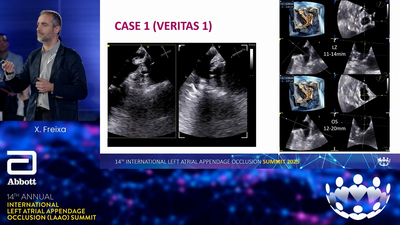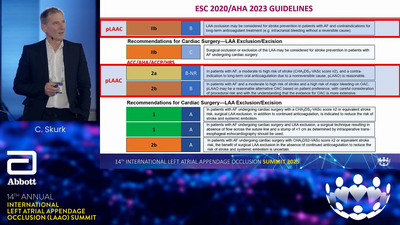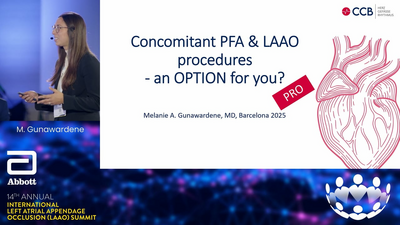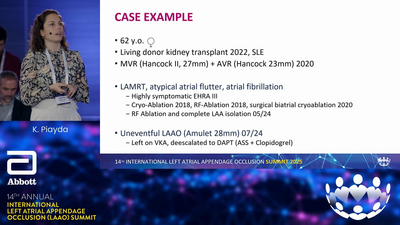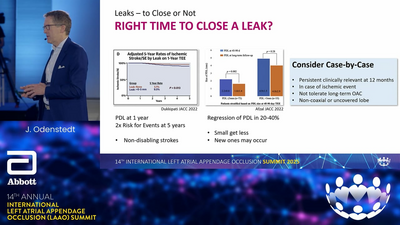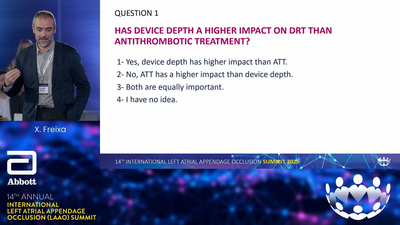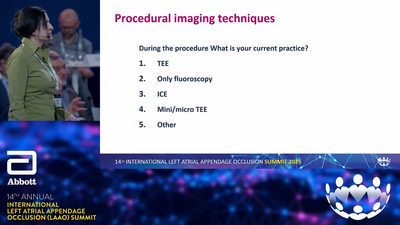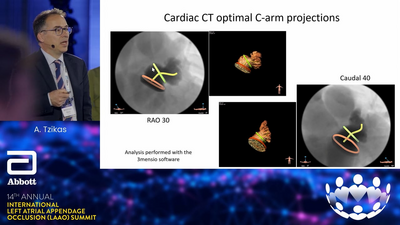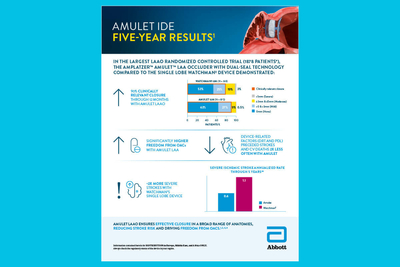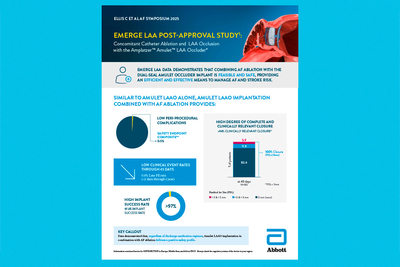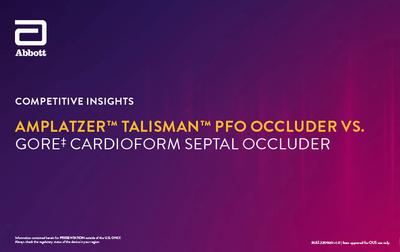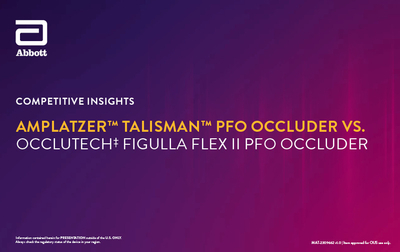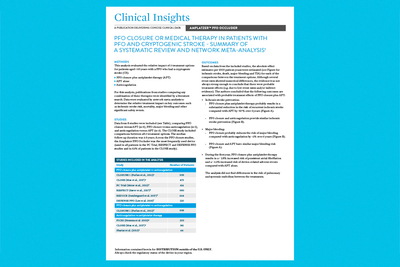Patent foramen ovale (PFO) is an embryonic defect associated with an increased risk of ischemic stroke.1 PFO closure combined with long-term antiplatelet therapy is recommended to prevent recurrent stroke in selected patients.2
PATENT FORAMEN OVALE (PFO)
The foramen ovale is vital for fetal circulation, when blood returning to the right atrium is shunted through to the left atrium. Post birth, the foramen ovale closes spontaneously in most people, but PFO occurs in about 25% of the population.3
Most people with a PFO are asymptomatic. But an atrial septal aneurysm (ASA) may open the PFO with every heartbeat, thereby increasing the possibility for a thrombus to pass from the venous to arterial system, which can cause a stroke.4

BEFORE BIRTH
Open foramen ovale

POST BIRTH
Natural closure of the foramen ovale

POST BIRTH
Foramen ovale remains open,
creating a PFO
PFO CLOSURE: BEHIND THE NUMBERS

Ischemic strokes are of unknown cause5

Of patients with an ischemic stroke of unknown cause have a PFO4

Patients with a PFO and a prior ischemic stroke of unknown cause are at risk for recurrent stroke6 - a 20.4% rate of recurrent embolic event at 2 Years7

Recurrent stroke risk reduction after PFO closure2
PFO-ASSOCIATED STROKE
A group of physicians with extensive knowledge of stroke and PFO have brought attention to the fact that new data indicate a need to update the classification schemes of the causative mechanism in stroke. Given the superiority of PFO closure over medical management in selected patients, new nomenclature should be used when looking at causation—and that is “PFO-associated stroke.” 8 Learn more about the rationale behind changing the causation classification by clicking on the link below.
TV
TV
HUB
- Kent DM, Thaler DE. Is patent foramen ovale a modifiable risk factor for stroke recurrence? Stroke. 2010;41(10 Suppl):S26–30. doi.org/10.1161/STROKEAHA.110.595140.
- Messé SR, Gronseth GS, Kent DM, et al. Practice advisory update summary: patent foramen ovale and secondary stroke prevention. Neurology. 2020;94(20):876–885.
doi.org/10.1212/WNL.0000000000009443. - Homma S, Sacco RL. Patent foramen ovale and stroke. Circulation. 2005;112(7):1063–1072. doi.org/10.1161/CIRCULATIONAHA.104.524371.
- Mojadidi MK, Zaman MO, Elgendy IY, et. al. Cryptogenic stroke and patent foramen ovale. J Am Coll Cardiol. 2018;71(9):1035–1043.
doi.org/10.1016/j.jacc.2017.12.059. - Saver JL. Clinical practice. Cryptogenic stroke. N Engl J Med. 2016;374(21):2065–2074. doi.org/10.1056/NEJMcp1503946.
- Kernan WN, Ovbiagele B, Black HR, et al. AHA/ASA guidelines for the prevention of stroke in patients with stroke and transient ischemic attack. Stroke. 2014;45(7):2160–2236. doi.org/10.1161/STR.0000000000000024.
- Homma S, Sacco RL, Di Tullio MR, et al. Effect of medical treatment in stroke patients with patent foramen ovale: patent foramen ovale in cryptogenic stroke study. Circulation. 2002;105(22):2625–2631. doi.org/10.1161/01.CIR.0000017498.88393.44.
- Elgendy AY, Saver JL, Amin Z, et al. Proposal for updated nomenclature and classification of potential causative mechanism in patent foramen ovale-associated stroke. JAMA Neurol. 2020;77(7):878–886. doi.org/10.1001/jamaneurol.2020.0458.
- Pristipino C, Sievert H, D’Ascenzo F, et al. European position paper on the management of patients with patent foramen ovale. EuroIntervention.
2019;14(13):1389–1402. doi.org/10.4244/EIJ-D-18-00622. - Kernan WN, Ovbiagele B, Black HR, et al. Guidelines for the prevention of stroke in patients with stroke and transient ischemic attack. Stroke.
2014;45:2160–2236. doi.org/10.1161/STR.0000000000000024. - Diener H-C, Sacco RL, Easton JD, et al. Dabigatran for prevention of stroke after embolic stroke of undetermined source. N Engl J Med. 2019;380(20):1906–1917. doi.org/10.1056/NEJMoa1813959
- Saver JL, Carroll JD, Thaler DE, et al. Long-term outcomes of patent foramen ovale closure or medical therapy after stroke. N Engl J Med. 2017;377:1022–1032. doi.org/10.1056/NEJMoa1610057.
- Kasner SE, Rhodes JF, Andersen G, et al. Five-year outcomes of PFO closure or antiplatelet therapy for cryptogenic stroke. N Engl J Med. 2021;384(10):970–971. doi.org/10.1056/NEJMc2033779.
- Mas J-L, Derumeaux G, Guillon B, et al. Patent foramen ovale closure or anticoagulation vs. antiplatelets after stroke. N Engl J Med. 2017;377(11):1011–1021. doi.org/10.1056/NEJMoa1705915.
- Kavinsky CJ, Szerlip M, Goldsweig AM, et al. SCAI guidelines for the management of patent foramen ovale. JSCAI. 2022;1(4)100039. doi.org/10.1016/j.jscai.2022.100039.
- Kleindorfer DO, Towfighi A, Chaturvedi S, et al. 2021 Guideline for the prevention of stroke in patients with stroke and transient ischemic attack: a guideline from the American Heart Association/American Stroke Association. Stroke. 2021;52(7):e364–e467. doi.org/10.1161/STR.0000000000000375.
- Diener H-C, Akagi T, Durongpisitkul K, et al. Closure of the patent foramen ovale in patients with embolic stroke of undetermined source: a clinical expert opinion and consensus statement for the Asian-Pacific region. Int J Stroke. 2020;15(9):937–944. doi.org/10.1177/1747493020941658.
- The Japan Stroke Society, The Japanese Circulation Society, and Japanese Association of Cardiovascular Intervention and Therapeutics Guidance on Percutaneous Closure of Patent Foramen Ovale (PFO) in Cryptogenic Stroke Patients. pfo-council.jp/publications/ (accessed April 2023).
- Diener H-C, Grau A, Baldus S. Cryptogenic stroke and patent foramen ovale (abridged and translated version). Neurol Res Pract. 2019;1(1):1–10.
doi.org/10.1186/s42466-019-0008-2. - Kuijpers T, Spencer FA, Siemieniuk RAC, et. al. Patent foramen ovale closure, antiplatelet therapy or anticoagulation therapy alone for management of cryptogenic stroke? A clinical practice guideline. BMJ. 2018;362:k2515. doi.org/10.1136/bmj.k2515.
- Wein T, Lindsay MP, Côté R, et. al. Canadian stroke best practice recommendations: secondary prevention of stroke, sixth edition practice guidelines, update 2017. Int J Stroke. 2018;13(4):420–443. doi.org/10.1177/1747493017743062.



